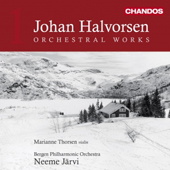
ESSENTIAL RECORDINGS

Johan Halvorsen (1864-1935), a rather unjustly ignored Norwegian composer, more than likely simply overshadowed by Edvard Grieg's popularity. His music, as in the well known Entry March of the Boyars which opens this CD, is always fresh, fun and entertaining. The composer he reminds me the most of is Franz von Suppé. The emotional content of most of the music is light, but with a very strong backbone of musical training as a violinist and conductor, the core of the music is always strong and bursting with good ideas and a solid structure which always yield interesting results.
The world premiere recording here of Andante Religioso, a piece for violin and orchestra, demonstrates that Halvorsen could write melodies just as beautiful as anyone else. It is very much in the same style as Massenet's "Meditation" from Thais. His talents as conductor and orchestrator come to the fore in the Suite from 'Mascarade', a nine movement collage of varying styles and ballet scenes alternating between grace and drama. The Menuetto from this suite bears a very strong and uncanny resemblance to the opening pages of the second movement of Gustav Mahler's Third Symphony. The main motif, the orchestration, the tempo and rhythm are exactly the same. So uncanny is the sameness as to become suspect. After all, Halvorsen was a conductor who had been known to conduct symphonies from Dvorak and Tchaikovsky, so surely he had been in contact with the Mahler symphony written 26 years earlier.
The main attraction on this CD is Halvorsen's Symphony No. 1, a composition from the 1920s that he thought was not modern enough for the times. These are his own words on the matter; "I write it because I want to and don't give a damn about either the present time or posterity." And even though it is written in a very traditional manner for that period, it is nonetheless written with a sure hand and a very strong control and understanding of all the facets that make for a great symphonic work. The opening Allegro presents and develops as strong a musical argument as any, and every consecutive movement builds from strength to strength and the whole work ends on a brilliant tour de force of thematic resolution.
Neeme Järvi and the Bergen Philharmonic are in top form with Chandos sonics to match. This is Volume 1 in what promises to be a fascinating overview of this up until now neglected composer from Norway.
Jean-Yves Duperron